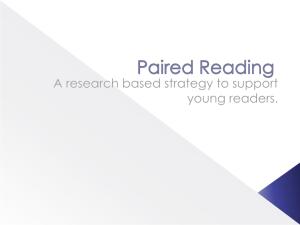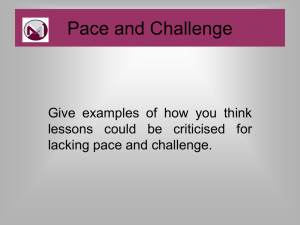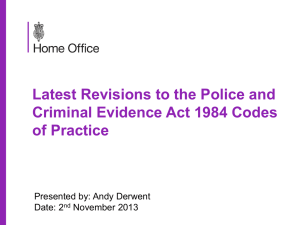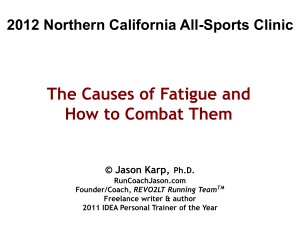Running Clinic - Periodization
advertisement
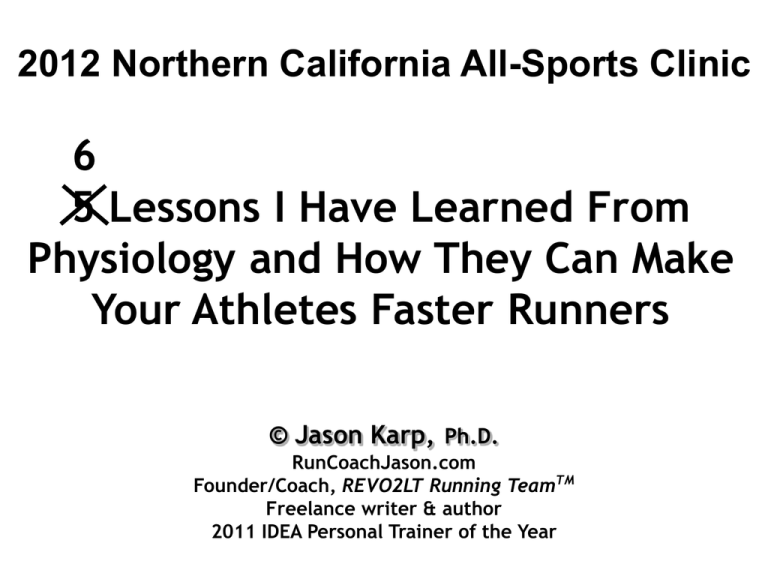
2012 Northern California All-Sports Clinic 6 5 Lessons I Have Learned From Physiology and How They Can Make Your Athletes Faster Runners © Jason Karp, Ph.D. RunCoachJason.com Founder/Coach, REVO2LT Running TeamTM Freelance writer & author 2011 IDEA Personal Trainer of the Year Lesson #1: To run fast, distance runners must first spend a lot of time running slow. Above all else, it’s the volume of training that induces the biological signal for adaptation and dictates the performance capacity. To accomplish a large training volume, runners must perform most of their running at a relatively slow pace. Aerobic running increases number of red blood cells & hemoglobin, giving blood vessels greater oxygencarrying capability; increases muscle capillary volume, providing more oxygen to muscles; & increases mitochondrial volume & number of aerobic enzymes, allowing for greater use of oxygen. Lesson #2: Lactate threshold and running economy are more important than VO2max. A high VO2max alone is not enough to attain elite-level performances; it simply gains one access into the club, since a runner cannot attain a high level of performance without a high VO2max. While athletes can improve their VO2max, it is largely genetically determined. The other two major physiological players of distance running performance—lactate threshold (LT) and running economy (RE)—exert a greater influence on a runner’s performance and are more responsive to training. Lactate Threshold • Slowest speed at which aerobic metabolism (Krebs cycle & electron transport chain) can’t keep up with production of pyruvate from glycolysis. • Fastest speed above which lactate production begins to exceed its removal, with blood lactate concentration beginning to increase exponentially. • Represents transition between running that is almost purely aerobic & running that includes significant oxygen-independent (anaerobic) metabolism. • Represents fastest speed that can be sustained aerobically. • Best physiological predictor of distance running performance. LT Pace Slower, recreational runners: ~ 10-15 sec/mile slower than 5K race pace (or ~ 10K race pace) ~ 75-80% max HR (~ 65-70% VO2max) Highly trained/elite: ~ 25-30 sec/mile slower than 5K race pace (or ~ 15-20 sec/mile slower than 10K race pace) ~ 90% max HR (~ 85-90% VO2max) Subjectively feel “comfortably hard” Types of LT Workouts Continuous LT Runs 3-4 miles up to 7-8 miles for marathoners LT Intervals intervals @ LT pace with short rest periods 4 x 1 mile @ LT pace w/ 1 min rest LT+ Intervals short intervals @ slightly faster than LT pace with very short rest periods 2 sets of 4 x 1,000 meters @ 10 sec/mile faster than LT pace w/ 45 sec rest & 2 min rest between sets LT/LSD Combo Run (for marathoners) Long continuous runs with portion @ LT pace 12-16 miles w/ last 2-4 miles @ LT pace 2 miles + 3 miles @ LT pace + 6 miles + 3 miles @ LT pace Running Economy In 1930, David Dill & his colleagues at the Harvard Fatigue Laboratory were among the first physiologists to suggest that there are marked differences in the amount of O2 different people use when running at the same speeds, and that these differences in “economy” of O2 use is a major factor explaining differences in endurance performance. Running Economy If two people have same VO2max, but Jack uses 70% & Martin uses 80% of that VO2max while running at 7:00 pace, the run feels easier for Jack because Jack is more economical. Therefore, Jack can run at faster speed before feeling same amount of fatigue as Martin. Running economy is the oxygen consumption (VO2) used to maintain a specific running speed. Running Economy • High mileage (>70 miles per week) seems to improve running economy. • optimized biomechanics • hypertrophy of Type I skeletal muscle fibers • greater skeletal muscle mitochondrial & capillary volumes • greater ability for tendons to store & utilize elastic energy • lower body mass • optimized motor unit recruitment patterns gained from countless repetitions of running movements • Heavy strength training & plyometrics improve economy, possibly by neural mechanism. Lesson #3: There are different muscle fiber types, which reflect a runner’s strengths and weaknesses. Slow-Twitch Fast-Twitch A Fast-Twitch B Contraction time Slow Fast Very Fast Size of motor neuron Small Large Very Large Resistance to fatigue High Intermediate Low Aerobic Long-term Anaerobic Short-term Anaerobic Force production Low High Very High Mitochondrial density High High Low Capillary density High Intermediate Low Oxidative capacity High High Low Glycolytic capacity Low High High Activity What Are My Strengths/Weaknesses? When you race, a) are you able to hang with your competitors during the middle stages, but get out-kicked in the last quarter to halfmile? b) do you have a hard time maintaining the pace during the middle stages, but can finish fast and out-kick others? If a, more ST fibers; if b, more FT fibers. Which type of workouts feel easier and more natural? a) long intervals (800m-mile repeats), long runs, and tempo runs b) short, fast intervals (200-400m repeats) If a, more ST fibers; if b, more FT fibers. Which workouts do you look forward to more? a) long intervals, long runs, and tempo runs b) short, fast intervals If a, more ST fibers; if b, more FT fibers. Train to Your Strengths • While improving an athlete’s weaknesses will make him/her more successful, focusing on his/her strengths will lead to best result. Athlete’s training should always be skewed in favor of what he/she is naturally good at. • If endurance-type runner, best at longer races; training should focus on aerobic work (mileage & lactate threshold training). • If speed-type runner, best at middle-distance races; training should focus on interval training. Train to Your Strengths If both runners train for same race: • endurance-type runner should initially do longer intervals, trying to get faster with training: • 1,200-meter reps @ 5K race pace, increasing speed to 3K race pace or decreasing recovery as training progresses • speed-type runner should do shorter intervals, trying to hold the pace for longer with training: • 800-meter reps @ 3K race pace, increasing distance to 1,200 meters or increasing number of reps as training progresses • two paths to meet at same point Lesson #4: Metabolism is tightly regulated by enzymes and oxygen. The amount of an enzyme and the availability of oxygen control which metabolic pathway predominates. Enzymes essentially control metabolism and therefore control the pace at which you fatigue. Having more aerobic enzymes steers metabolism toward a greater reliance on aerobic metabolism at a given speed. Training increases enzyme activity. When pyruvate is converted to lactate, metabolites accumulate & acidosis develops, causing muscles to Lactate fatigue & pace to slow down. Lesson #5: A larger, stronger heart can pump more blood and oxygen to your muscles. Distance running is primarily limited by delivery & use of oxygen, the former of which is dictated by the amount of blood pumped by your heart per minute (cardiac output). Specific training can make the heart larger & increase stroke volume & cardiac output. Work periods run at speed at which VO2max occurs provide the heaviest load on cardiovascular system because of repeated attainment of maximum stroke volume & cardiac output (and, by definition, VO2max). VO2max Pace Slower, recreational runners: 1- to 1½-mile race pace (near max HR) Highly trained/elite: ~2-mile race pace (10-15 sec/mile faster than 5K race pace; near max HR) Examples of Workouts: • 5-6 x 800 meters (~3 min) @ VO2max pace w/1:≤1 work-to-rest ratio • 4-5 x 1,000 meters (~4 min) @ VO2max pace w/1:≤1 work-to-rest ratio • 3 x 1,200 meters (~4½-5 min) @ VO2max pace w/1:≤1 work-to-rest ratio Work Periods VO2max (HRmax) VO2 (HR) Recovery Periods Reps Lesson #6: Refueling immediately maximizes recovery. Two important fuels to replenish after training are carbohydrates & protein. Endurance performance is strongly influenced by amount of muscle glycogen, with intense endurance exercise decreasing muscle glycogen content. Recovery is closely linked to replenishment of carbohydrates, with glycogen resynthesis most rapid if carbs are consumed immediately after workout (0.7 gram of simple carbs (e.g., glucose) per pound within 30 minutes & every 2 hours for 4-6 hours). Protein rebuilds skeletal muscle fibers that have been damaged from training.


